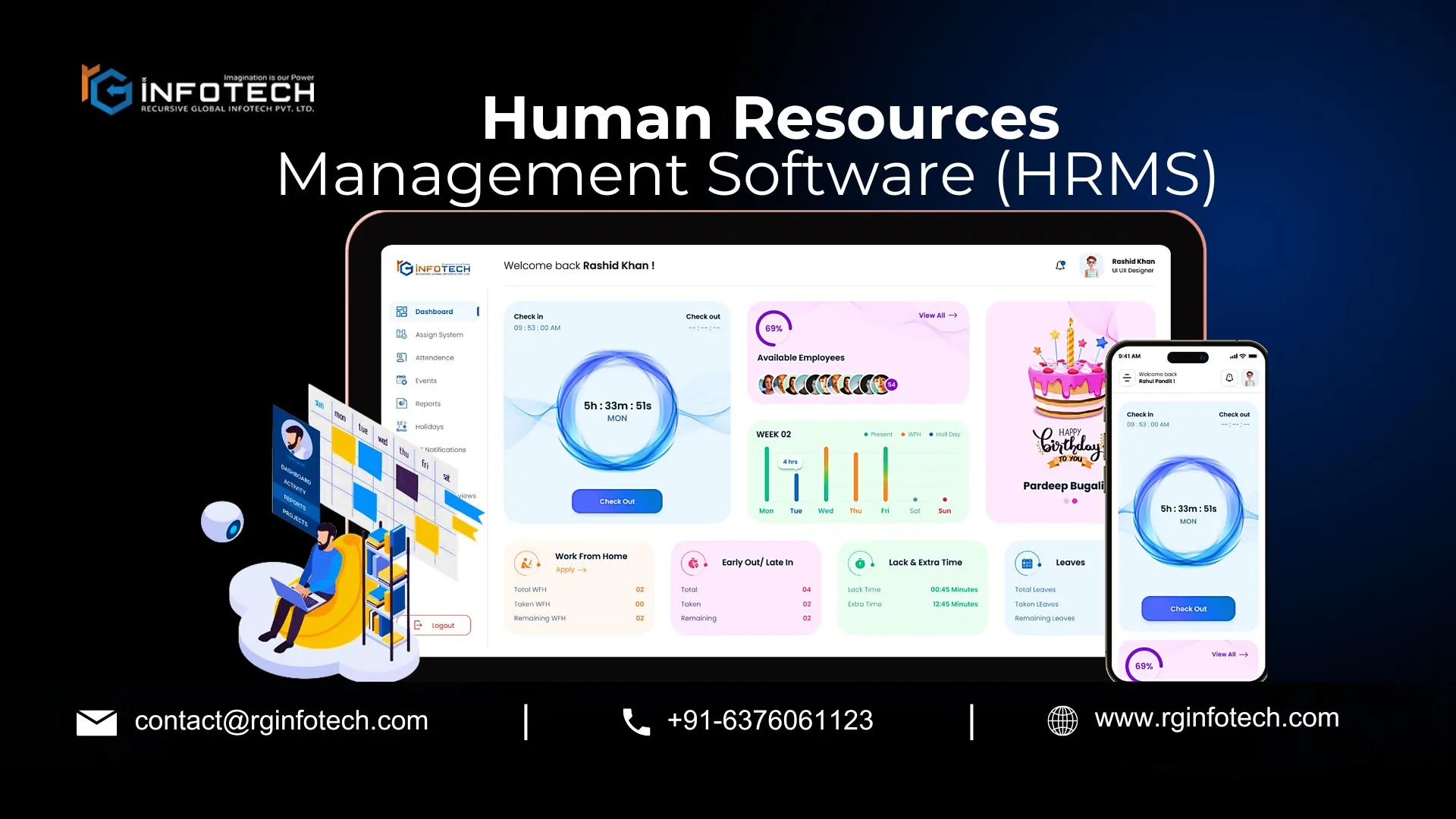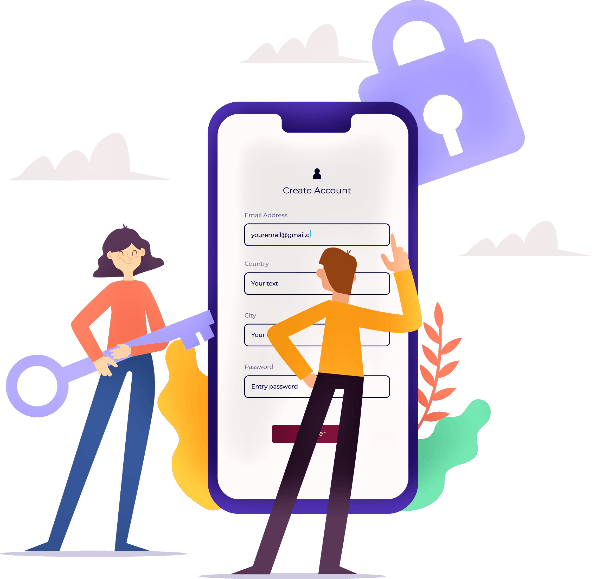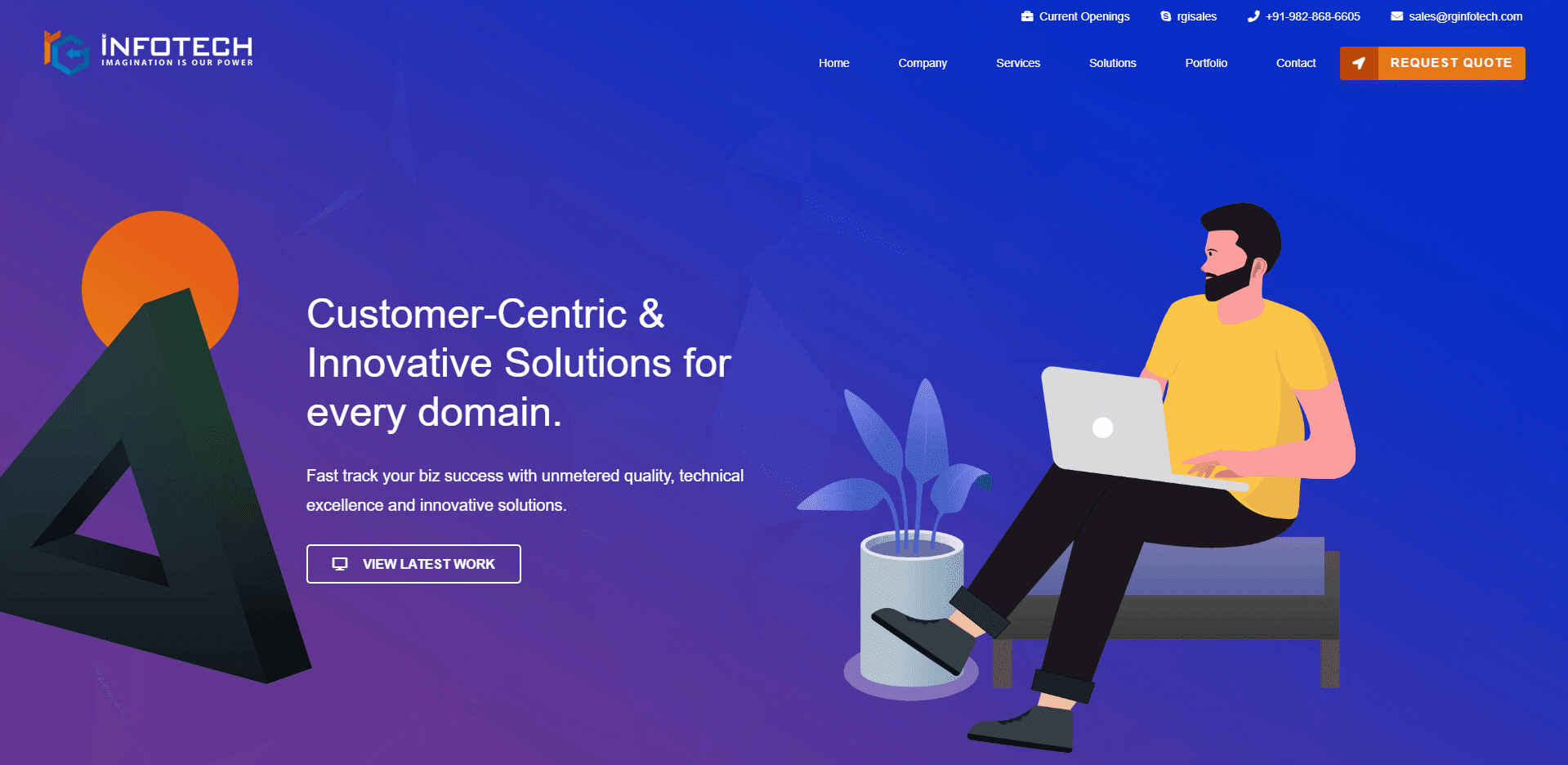Best Human Resource Management Software: HRMS

HR departments often have to multitask, and without human resource management software, HR operations can become messy. HRMS is software designed specifically for HR departments of various big and small enterprises to simplify their tasks involving payroll, benefit management, employee recruitment, training, evaluation, retention, and performance management.
Smooth sailing of HR operations depends on a well-designed HRMS. It saves time and resources and provides a better experience for employees. The system includes all the important components and systems that the HR department may need but in an automated process.
In simple terms, HRM system software is the one-stop solution to manage most HR responsibilities and help create a better, happier, and more productive workplace. In today’s blog, we will discuss some of the crucial components and features of HRMS software to help you select the best software that can benefit your business.
Types of HRM Software
HRM application software involves a wide range of tools and technologies specifically designed to streamline and improve HR operations and tasks within organizations. Although there are plenty of variations in HR software, the most renowned and useful ones are the Human Resource Information System (HRIS), the Human Capital Management (HCM) system, and comprehensive HRMS solutions. Each of these types has its own distinction and importance and serves various organizational requirements.
HRIS (Human Resource Information System)
Acts as an interactive system of information management that mainly focuses on managing employee information in a detailed manner and automating administrative policies and procedures associated with human resources. HRIS software incorporates functionalities such as employee records management, compliance monitoring, time and attendance tracking, and payroll processing.
Essentially, HRIS acts as a “two-way lane” through which organizations can collect information about the employees and vice versa. By eliminating paper-based and manual HR-related processes, an HRIS provides more seamless, streamlined, and efficient interactions between organization and workforce while allowing HR professionals to perform more strategic and high-value work.
HCM (Human Capital Management)
Is a set of practices that extend the capabilities of HRIS by aiming at the complete employee lifecycle, including attracting, recruiting, training, developing, supervising, and performance tracking, and retaining employees to meet business agendas. Human capital management helps organizations that rely on employees to identify gaps and faults in employees’ capabilities and shift their focus on hiring efforts toward meeting those needs.
This system is designed to align workforce strategy with business goals, emphasizing the employee journey within the organization. By using HCM, employees can have more grip over their careers and are encouraged to dedicate their skills to the organization.
HRMS (Human Resource Management System)
Human Resource Management System (HRMS) combines features and functionalities of both HRIS and HCM, offering a more comprehensive approach to HR management. It typically includes functionalities like recruitment and payroll. Onboarding and advanced analytics. HRMS software prioritizes administrative efficiency as well as strategic workforce management, catering to organizations that require a full suite of HR capabilities.
Today’s advanced HR software solution has transformed the way HR systems work. They have replaced traditional paper-based processes by automating HR tasks. It allows the HR department to reduce human errors and emphasize higher value, leading to more rewarding work.
Specialized HR Software Types
In addition to HRIS, HCM, and HRMS, several specialized types of HR software serve specific needs within HR management. Examples include recruitment software for HRM that assists in job postings and CV screening, employee scheduling software for managing work shifts, and performance management systems that monitor and evaluate employee performance. These specialized tools can integrate with broader HRMS solutions to create a cohesive HR management environment.
Looking an app for your business?
Let’s discuss your idea with us on coffee.
Key Features to Include in HRMS Software
A top human resource management system (HRMS) must have various core features and functionalities to empower HR operational efficiency. These features play an important role in shaping the management structure of the HR department by enhancing their HR processes, enhancing employee engagement, and leveraging data for better decision-making.
The key features can be divided into three major categories: general HR functionalities, time and attendance management capabilities, and robust analytics tools. Let’s learn about these features in detail:
General HR Features
Mobile Compatibility:
Mobile compatibility is an integral part of modern HRM solutions. It allows employees and managers to access HR services anytime, anywhere, and from any device. Thai features ensure the accessibility of her functions, facilitating quick decision-making and taking prompt actions.
Benefits Administration:
A comprehensive benefits administration module helps streamline employee benefits management, including health insurance and retirement plans. This feature enhances employee satisfaction and ensures compliance with relevant regulations.
Self-Service (Employee):
Self-service capabilities empower employees to manage their personal information, including updating contact details, accessing pay stubs, and submitting leave requests. This reduces the administrative burden on HR departments and fosters a sense of ownership among employees.
Self-Service (Management):
With the help of self-management tools, HR managers can perform functions such as approving leave requests and accessing team performance data. This speeds up decision-making processes and improves overall HR operations.
Learning and Development:
This module supports employee development and growth by giving them access to training resources, onboarding programs, and development opportunities. A focus on continuous learning helps retain talent and equips employees with the necessary skills for career progression.
Time & Attendance Features
Employee Scheduling:
Effective employee scheduling functionalities enable managers to allocate shifts depending on the operational requirements. This feature optimizes staffing levels and enhances workforce productivity by minimizing scheduling conflicts.
Absence Management:
Absence management tools of HRMS global software assist organizations in keeping track of employee leaves, reducing unauthorized leaves, and ensuring compliance with labor laws. This system plays a crucial role in keeping workplace integrity and ensuring proper coverage.
Cost Estimates:
The cost estimation feature offers crucial insight into labor expenses related to scheduling and attendance management. This feature enables HR departments to plan budgets smartly and optimize labor costs according to business requirements.
Payroll Integration:
seamless integration with payroll systems streamlines the calculation of wages, bonuses, and deductions. This ensures accurate payroll processing and facilitates compliance with tax regulations.
Compliance Management:
Compliance management features help ensure that organizations adhere to labor laws and regulations regarding attendance and leave policies. This module is crucial for mitigating legal risks and maintaining compliance.
Analytics Features
Automated Data Gathering:
This feature automates the collection of HR-related data, streamlining processes and enhancing accuracy in reporting. Automated data gathering reduces manual entry errors and saves time for HR personnel.
Real-time Reporting:
Real-time reporting capabilities allow HR professionals to visualize key metrics and trends as they occur. This urgency supports data-driven decision-making and proactive management interventions.
Forecasting Capabilities:
HRMS software should include forecasting tools that leverage historical data to predict future staffing needs, turnover rates, and other critical HR metrics. This forward-looking capability allows organizations to prepare strategically for upcoming challenges.
Customizable Dashboards:
Customisable dashboards provide HR leaders with a tailored view of their relevant data, enabling them to focus on the most pertinent information for their roles. This flexibility enhances usability and helps prioritize tasks effectively.
Access Controls:
Access controls are necessary for protecting sensitive employee information and ensuring that only authorized personnel can access specific data. Implementing strict access controls enhances data security and compliance with privacy regulations.
By incorporating these key features into online HR software, organizations can ensure that they streamline HR processes, enhance employee experience, and utilize data effectively for strategic planning.
Benefits of Human Resource Management Software
HRMS software offers numerous benefits to both employees and organizations. By streamlining administrative tasks, improving data management and compliance, enabling informed decision-making, and enhancing the employee experience, HR software represents a valuable investment for businesses aiming to optimize their HR functions and drive organizational success.
Time Savings
HRM software significantly saves time by automating routine HR tasks such as payroll processing, absence tracking, and employee onboarding. By automating these time-consuming activities, HR professionals can redirect their focus toward strategic initiatives that enhance business performance. This leads to improved productivity as HR teams no longer spend excessive time on manual administrative tasks.
Centralised Data Management
One of the key benefits of HRM software is the ability to centralize employee data. This ensures that all personnel information, from performance reviews to payroll details, is securely stored in one location. Centralized data management improves accessibility for both HR staff and employees, enabling quick decision-making and reducing the risk of data loss during communication between teams.
Enhanced Employee Development
HRM software facilitates employee development by providing tools for performance management, training tracking, and skill assessments. Organizations can log performance reviews and training progress, ensuring that employees receive timely feedback and opportunities for growth. This focus on continuous development helps improve employee engagement and retention.
Improved Compliance Management
Compliance with local and international regulations is crucial for any organization. Hrm software helps maintain compliance by ensuring proper documentation and providing an electronic paper trail necessary for audits or legal investigations. Automated compliance features also help organizations stay updated with changing regulatory requirements, minimizing the risk of legal issues.
Better Decision-Making through Analytics
HRM software often includes reporting and analytics features that allow organizations to analyze workforce data effectively. By leveraging HR metrics, businesses can identify trends such as employee turnover rates or training needs, which informs decision-making. This analytical capability allows for proactive management of human resources, leading to more strategic planning and enhanced overall performance.
Streamlined Recruitment Process
HRM software aids in the recruitment process by simplifying job postings, tracking applicants, and managing the onboarding process. Automated tools allow HR professionals to easily communicate with candidates and streamline their integration into the organization. This enhances the overall candidate experience and helps attract top talent.
Increased Security for Employee Information
With sensitive employee data being stored digitally, HRM software enhances data security through various measures, including access controls and encryption protocols. This helps protect against data breaches and unauthorized access, ensuring that employee information is kept secure. By moving away from paper-based systems, organizations also reduce the risk of physical data loss due to disasters.
List of HRMS Software Tools
Here are some of the top HR software tools that may help you choose the best HR system for your budget and business requirements.
1. Greenhouse
Greenhouse is a powerful applicant tracking system that focuses on improving the recruiting process. It offers collaborative hiring tools and workflow automation, making it easier for teams to manage candidate engagement and selection efficiently.
2. Deel
DEEL provides an all-in-one HR platform aimed at managing and growing global teams. It features cutting-edge HR tools, automated payroll, and compliance management, enabling businesses to scale internationally with ease.
3. Paycor
Paycor specializes in human capital management (HCM) solutions that unify various HR processes. It provides tools for recruitment, payroll, and benefits management, helping organizations engage employees and optimize their workforce.
4. Workable HR
Workable HR is designed to simplify the hiring and employee management processes. It offers a suite of products aimed at enhancing recruitment efforts and managing employee data efficiently.
5. Oyster HR
Oyster HR is a global employment platform that facilitates compliant, automated hiring across various regions. It combines local intelligence with comprehensive HR tools, allowing businesses to manage their workforce anywhere.
6. Rippling
Rippling integrates various HR functions, including payroll, benefits, and IT management, into one platform. It is designed to streamline administrative tasks and improve operational efficiency, particularly for small and medium-sized businesses.
7. Lattice
Lattice focuses on performance management and employee engagement. Its platform allows HR professionals to track productivity, conduct performance reviews, and foster employee development through continuous feedback mechanisms.
8. GoCo
GoCo is an all-in-one HR solution that automates tasks including onboarding, benefits administration, and compliance management. Designed for small businesses, it aims to simplify HR operations and enhance the user experience.
9. ADP HR Services
ADP offers comprehensive HR solutions that include payroll, tax management, compliance, and benefits administration. Its robust platform is designed to meet the needs of businesses of all sizes.
10. PrimePay
PrimePay provides an integrated platform that centralizes payroll, HR management, and employee benefits. Its software is tailored for businesses looking to streamline their HR tasks and improve organizational efficiency.
This list highlights some of the top HRMS tools available today, each with unique features tailored to enhance HR operations and improve the overall employee experience.
What is The Cost of HRMS Software?
The crucial aspect of any HR software solution is fair, transparent, and scalable pricing. Any top HRM software provider offers various pricing options to cater to the needs of small businesses and startups, midsize businesses, and enterprise businesses. As with any major purchase, there are various methods of paying or withdrawing the payment for your new HRMS. Depending on your business requirements, your pricing models may play a significant role in your choice of system.
The decision to invest in an HRMS is a big deal. So, when considering investing in HEMS, remember that businesses generally spend $6,125 per user for their HRMS system over five years, according to HRIS research. This makes it even more important for you to understand the best pricing model that fits your business requirements. There are three basic approaches to pricing: subscription, license, and free.
Subscription Pricing:
In the subscription model, users pay a recurring fee (monthly, quarterly, or annually) to access a product or service.
Key Features:
- Continuous access to updates and support.
- Predictable, recurring revenue for businesses.
- Often includes different pricing tiers based on features or usage.
- Best For: SaaS products, streaming services, and ongoing service platforms.
License Pricing:
In this model, you need to pay a one-time fee to obtain a license to use the software or product indefinitely, though updates or support may require additional costs.
Key Features:
- Permanent access to the purchased version of the product.
- May offer both individual and enterprise-level licenses.
- Additional fees might apply for newer versions or technical support.
- Best For: Traditional software packages and enterprise solutions.
Free (Freemium) Pricing:
In this one, they offer products free of cost with basic features, but users can pay for premium features, services, or upgrades.
Key Features:
- It attracts a large user base with free access.
- Monetization through premium features, in-app purchases, or ads.
- Allows users to experience the product before committing to paid options.
- Best For Apps, online tools, and platforms aiming for mass adoption.
Each of these pricing strategies has its strengths and is suited for different business models and customer segments.
Conclusion
The above-provided details and information throw light on the best human resource management software (HRMS) and the crucial factors associated with it. These factors and components help HR operations by providing the right solution to organizations so that they can better meet their HR needs and drive operational success. Read the above context to get a better understanding of HR management software, and stay tuned for more informative updates regarding HRMS.
Frequently Asked Questions (FAQs)
HRMS (Human Resource Management System) is software that helps organizations manage various HR functions such as employee data, payroll, recruitment, time and attendance, performance management, and benefits administration in one centralized platform.
- HRMS (Human Resource Management System): A broader system that includes HRIS and focuses on managing people and payroll functions.
- HRIS (Human Resource Information System) primarily focuses on storing employee data and basic HR functions like attendance and compliance.
- HCM (Human Capital Management): Encompasses all aspects of employee management, from hiring to retirement, with a focus on strategic workforce management.
Key features include employee data management, payroll processing, time and attendance tracking, recruitment, performance management, benefits administration, reporting, and compliance management.
HRMS automates manual tasks, reduces administrative burden, minimizes human errors, and provides real-time access to HR data. It streamlines processes like payroll, leave management, and recruitment, allowing HR teams to focus on strategic activities.
Yes, many HRMS solutions are scalable and offer pricing options that cater to small businesses. Cloud-based HRMS platforms, in particular, are often cost-effective for smaller companies.



 rgisales
rgisales



